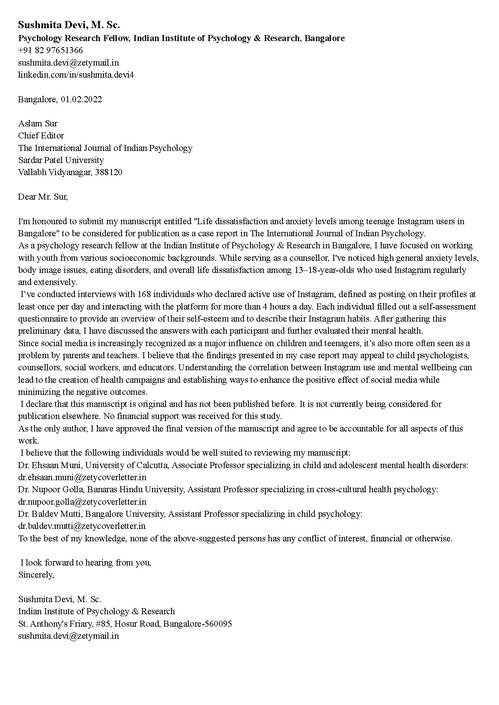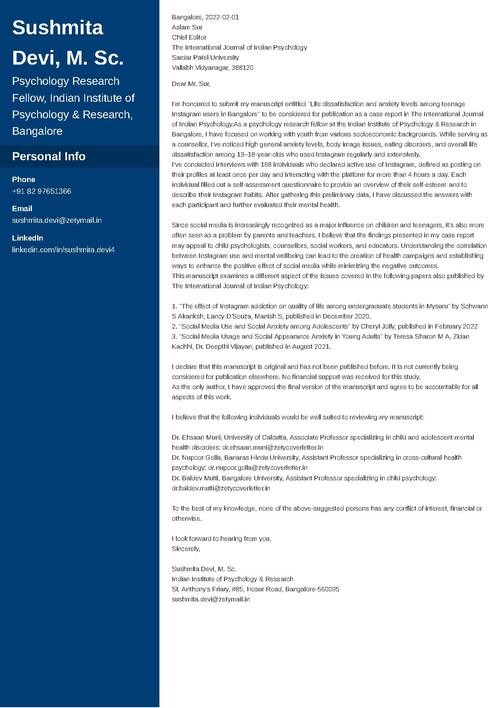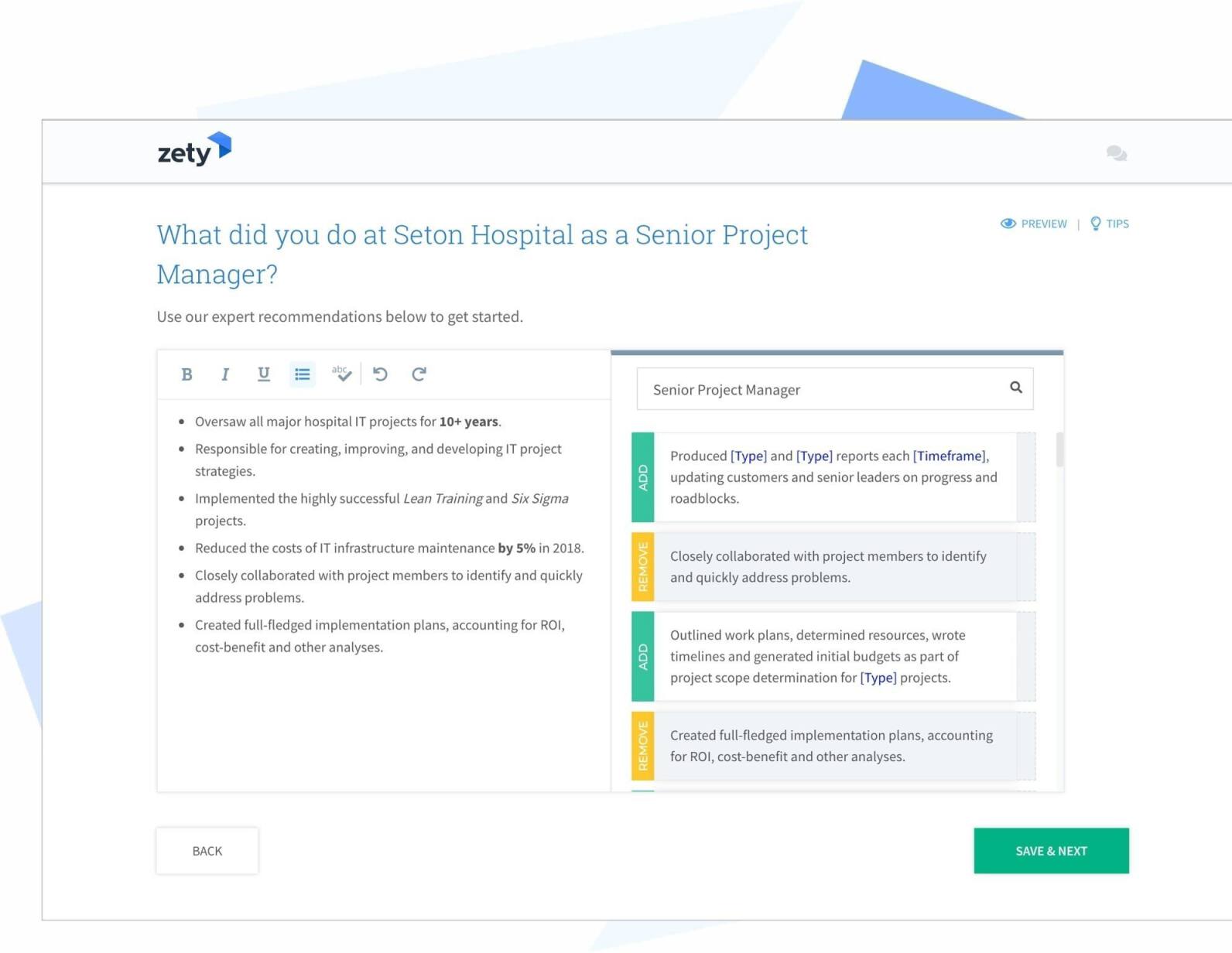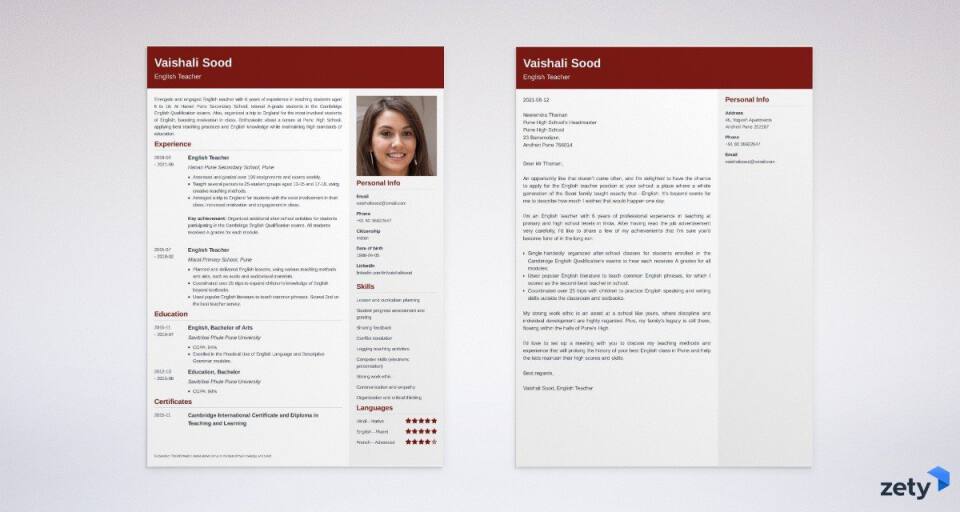Cover Letter for Journal Submission: Sample & How To Write
Create your cover letter nowEvery day, you help the world to move forward. Conducting research, performing tests, and working on scientific experiments are a part of your routine. The data you’ve collected must be processed and presented in a neat manuscript.
But wait. Who’s going to read it? Oh, right. You must have an audience. But not just any audience—you need scientists like you to read and review your paper. And to reach them, you must send your work to scientific journals.
To make sure your groundbreaking findings get published in reputable journals, you must write a professional cover letter for journal submission.
This guide will show you:
- A cover letter for journal submissions better than 9 out of 10 others.
- A sample cover letter for manuscript submission that gets your work published.
- A step-by-step guide on how to write a cover letter for a journal submission.
- How a neat abstract can put your scientific career on the right track.
Want to write your cover letter fast? Use our cover letter builder. Choose from 20+ professional cover letter templates that adapt to your content and already have all the formatting in place. Make your document look perfect with zero effort!


That’s a sample cover letter for a journal submission made with our builder. See more cover letter templates and create your cover letter here.
Check this cover letter for journal submission sample:
Cover Letter for Journal Submission Sample
Sushmita Devi, M. Sc.
Psychology Research Fellow, Indian Institute of Psychology & Research, Bangalore
+91 82 97651366
sushmita.devi@zetymail.in
linkedin.com/in/sushmita.devi4
Bangalore, 01.02.2022
Aslam Sur
Chief Editor
The International Journal of Indian Psychology
Sardar Patel University
Vallabh Vidyanagar, 388120
Dear Mr. Sur,
I'm honoured to submit my manuscript entitled "Life dissatisfaction and anxiety levels among teenage Instagram users in Bangalore" to be considered for publication as a case report in The International Journal of Indian Psychology.
As a psychology research fellow at the Indian Institute of Psychology & Research in Bangalore, I have focused on working with youth from various socioeconomic backgrounds. While serving as a counsellor, I've noticed high general anxiety levels, body image issues, eating disorders, and overall life dissatisfaction among 13–18-year-olds who used Instagram regularly and extensively.
I’ve conducted interviews with 168 individuals who declared active use of Instagram, defined as posting on their profiles at least once per day and interacting with the platform for more than 4 hours a day. Each individual filled out a self-assessment questionnaire to provide an overview of their self-esteem and to describe their Instagram habits. After gathering this preliminary data, I have discussed the answers with each participant and further evaluated their mental health.
Since social media is increasingly recognized as a major influence on children and teenagers, it’s also more often seen as a problem by parents and teachers. I believe that the findings presented in my case report may appeal to child psychologists, counsellors, social workers, and educators. Understanding the correlation between Instagram use and mental wellbeing can lead to the creation of health campaigns and establishing ways to enhance the positive effect of social media while minimizing the negative outcomes.
This manuscript examines a different aspect of the issues covered in the following papers also published by The International Journal of Indian Psychology:
- "The effect of Instagram addiction on quality of life among undergraduate students in Mysuru" by Schwann S Akanksh, Lancy D’Souza, Manish S, published in December 2020.
- "Social Media Use and Social Anxiety among Adolescents" by Cheryl Jolly, published in February 2022
- "Social Media Usage and Social Appearance Anxiety in Young Adults" by Teresa Sharon M A, Zidan Kachhi, Dr. Deepthi Vijayan, published in August 2021.
I declare that this manuscript is original and has not been published before. It is not currently being considered for publication elsewhere. No financial support was received for this study.
As the only author, I have approved the final version of the manuscript and agree to be accountable for all aspects of this work.
I believe that the following individuals would be well suited to reviewing my manuscript:
- Dr. Ehsaan Muni, University of Calcutta, Associate Professor specializing in child and adolescent mental health disorders: dr.ehsaan.muni@zetycoverletter.in
- Dr. Nupoor Golla, Banaras Hindu University, Assistant Professor specializing in cross-cultural health psychology: dr.nupoor.golla@zetycoverletter.in
- Dr. Baldev Mutti, Bangalore University, Assistant Professor specializing in child psychology: dr.baldev.mutti@zetycoverletter.in
To the best of my knowledge, none of the above-suggested persons has any conflict of interest, financial or otherwise.
I look forward to hearing from you,
Sincerely,
Sushmita Devi, M. Sc.
Indian Institute of Psychology & Research
St. Anthony's Friary, #85, Hosur Road, Bangalore-560095
sushmita.devi@zetymail.in
See? Not that complicated! Yet, it brings you a few steps closer to getting that research paper published.
Thinking of improving on your resume to better present yourself to the academic community? Check this guide: How to Write a Resume for a Job: See a Good Sample & Guide
Now, let’s see how to write a cover letter for journal submission:
1. Start With the Proper Cover Letter for Journal Submission Template
Appearances matter. You wouldn’t wear a baggy T-shirt and shorts to an academic conference. In the same way, you don’t want your cover letter for journal submission to look sloppy.
Follow these steps to create a professional template:
Cover Letter for Journal Submission Checklist
- Add your contact information, degree, name of the institution
- List the editor’s name, the name of the journal, address, and submission date
- Greet the editor by name: Dear Mr./Mrs. XYZ
- Say the title of your manuscript
- Explain your motivation behind this paper
- Summarize the research in an abstract
- Highlight why readers might be interested in your paper
- Mention past papers from this journal that explored similar themes
- Add mandatory declarations
- Point to potential reviewers
- Regards + your info
Interested in writing a cover letter as well? Read more: How to Write a Cover Letter: Examples & Full Guide
2. Begin Your Cover Letter for Journal Submission Strong
Scientific journals receive hundreds of submissions on a daily basis. Even if your research is truly groundbreaking, they might overlook it.
Hoping to see your name in The Lancet? Then start with putting it in your cover letter! Make sure to also include your contact information, degree, and the academic institution that backs you up. Then, list the information of the chief editor you’re addressing.
But that’s not all!
The first paragraph of your cover letter for journal submission must present the title of your manuscript. It’s also worth noting the type of article, such as review, case study, research, etc. Then, explain why you’ve conducted your research and mention the main findings.
Cover Letter for Journal Submission Sample
| Right |
|---|
Sushmita Devi, M. Sc. Psychology Research Fellow, Indian Institute of Psychology & Research, Bangalore +91 82 97651366 sushmita.devi@zetymail.in linkedin.com/in/sushmita.devi4 Bangalore, 1.02.2022 Aslam Sur Chief Editor The International Journal of Indian Psychology Sardar Patel University Vallabh Vidyanagar, 388120 Dear Mr. Sur, I'm honoured to submit my manuscript entitled "Life dissatisfaction and anxiety levels among teenage Instagram users in Bangalore" to be considered for publication as a case report in The International Journal of Indian Psychology. As a psychology research fellow at the Indian Institute of Psychology & Research in Bangalore, I have focused on working with youth from various socioeconomic backgrounds. While serving as a counsellor, I've noticed high general anxiety levels, body image issues, eating disorders, and overall life dissatisfaction among 13–18-year-olds who used the Instagram platform regularly and extensively. |
This example presents the themes of the manuscript in a clear and concise manner. It includes all the essential information.
| Wrong |
|---|
Dear Sirs, I’d like you to consider my article “Troubles in early detection of childhood depression among children from Scheduled Castes” for publication. I specialize in child psychology, and I’ve completed an internship in Child Health Center in Lucknow. My article sums up my experience working with children there. |
While the title of the article sounds promising, the information provided by the author doesn’t explain why they chose this particular subject and what they focused on.
Pro Tip: Many journals, including Nature, Science, and Elsevier, list the exact information required in the cover letter for journal submissions. Make sure to check the requirements of your preferred journal before writing your cover letter!
3. Put the Abstract in the Middle of Your Cover Letter for Journal Submission
The editor’s attention spiked after the intro, but now it dropped.
Why?
Because you started rambling about your unique findings without mentioning how you got to these conclusions. They’ve decided you’re just a dreamer with no facts to back up your ideas.
Don’t try to shake the world—first, prove you know what you’re talking about:
- Describe your scientific methods and type of data you’ve collected.
- Mention why your study is important and who might benefit from it.
- List articles that covered similar themes.
See? There’s no need for a lengthy essay here.
Check this cover letter for journal submission sample to see what I’m talking about:
Cover Letter for Journal Submission—Middle Part
| Right |
|---|
I’ve conducted interviews with 168 individuals who declared active use of Instagram, defined as posting on their profiles at least once per day and interacting with the platform for more than 4 hours a day. Each individual filled out a self-assessment questionnaire to provide an overview of their self-esteem and to describe their Instagram habits. After gathering this preliminary data, I have discussed the answers with each participant and further evaluated their mental health. Since social media are increasingly recognized as a major influence on children and teenagers, they’re also more often seen as a problem by parents and teachers. I believe that the findings presented in my case report may appeal to child psychologists, counsellors, social workers, and educators. Understanding the correlation between Instagram use and mental wellbeing can lead to the creation of health campaigns and establishing ways to enhance the positive effect of social media while minimizing the negative outcomes. This manuscript examines a different aspect of the issues covered in the following papers also published by The International Journal of Indian Psychology.
|
You’ve got it all! This shows the editor you know what you’re talking about. You aren’t a pseudo-scientist trying to push your intuitive beliefs on others.
| Wrong |
|---|
I talked to about 100 students who often use the Internet. They told me about the emotions they felt while browsing social media platforms. Most students frequently felt upset and envious of successful influencers. I believe this study can help parents and teachers to understand why young people have difficult behaviours and can’t focus on studying. Since your journal regularly includes articles about similar topics, I think my study is a good fit here. |
Ouch. That’s really vague. It doesn’t seem convincing—maybe the author isn’t really a scientist?
Pro Tip: Writing about your research in English may not be as natural to you as chatting with fellow researchers over lunch. Studies show that many papers from non-English speaking authors are regularly rejected by editors because of incorrect grammar. If you need to improve your language skills, consider joining courses specifically for scientists, such as Coursera’s English for Science, Technology, Engineering, and Mathematics.
Making a resume with our builder is incredibly simple. Follow our step-by-step guide, use ready-made content tailored to your job and have a resume ready in minutes.
When you’re done, Zety’s resume builder will score your resume and tell you exactly how to make it better.
4. Add Mandatory Declarations to Your Cover Letter for Journal Submission
Now, this is a very easy part.
Most journals require authors to include various statements. They provide backing for the journal in case of legal issues.
Those may include:
- Statement that none of the material has been previously published or is currently under consideration for publication in another journal
- Statement that informed consent was obtained for investigations on humans
- Statement that animals’ care during the study was in accordance with local guidelines
- Statement regarding possible conflict of interest, funding sources, competing interests, etc.
To make sure you included all required clauses, always check the requirements of the journal.
Cover Letter for Journal Submission—Mandatory Clauses
| Right |
|---|
I declare that this manuscript is original and has not been published before. It is not currently being considered for publication elsewhere. No financial support was received for this study. As the only author, I have approved the final version of the manuscript and agree to be accountable for all aspects of this work. |
It’s clear and easy to understand. The required statements are covered here.
| Wrong |
|---|
I confirm that I am the author of this article and that I used my own funds to conduct research. |
There aren’t enough details here. It’s always best to just paraphrase the clauses listed in submission requirements.
Pro Tip: Always be upfront about a potential conflict of interest, especially when your research was financed by a private institution. There’s no shame in getting private funding! In the U.S., over 70% of research and development is funded by the private sector.
5. Finish Your Cover Letter for Journal Submission
Now it’s time for the last step: the ending!
But before you can click “send” on your submission, there’s one more important thing.
The reviewers.
That’s one of the goals of your submission—to get your article reviewed by other scientists. This way, you become more trustworthy. It will also help to gain interest in your research, which might lead to future job opportunities.
Think of 3–5 persons from the academic community who might be interested in your research. It’s best if they study similar themes or published articles on related topics. Pay attention to potential conflicts of interest!
Cover Letter for Journal Submission—Ending
| Right |
|---|
I believe that the following individuals would be well suited to reviewing my manuscript:
To the best of my knowledge, none of the above-suggested persons has any conflict of interest, financial or otherwise. I look forward to hearing from you, Sincerely, Sushmita Devi, M. Sc. Indian Institute of Psychology & Research St. Anthony's Friary, #85, Hosur Road, Bangalore-560095 sushmita.devi@zetymail.in |
It’s pretty clear why these individuals could be interested in reviewing this article—they all specialize in similar topics.
| Wrong |
|---|
I would appreciate it if you could point me to any scientists who might be interested in reading and peer-reviewing my manuscript. Best regards, Charandeep Chawla |
A great cover letter that matches your CV will give you an advantage over other candidates. You can write it in our cover letter builder here. Here's what it may look like:
See more cover letter templates and start writing.
Key Takeaway
This is the easiest formula to write a cover letter for journal submission:
- Use the proper format for a cover letter for journal submission to make sure you include essential information.
- State the reasoning behind your article.
- Show your methods to prove you’re a serious scientist.
- Point to readers who could benefit from your research.
- Include mandatory statements.
- Mention potential reviewers.
Now get to writing!
Not sure how to customize your cover letter to the journal’s requirements? Having trouble describing your research methods? Leave a comment below. I’ll be happy to assist you!
About Zety’s Editorial Process
Our editorial team has reviewed this article in depth to make sure it follows Zety’s editorial guidelines. We’re committed to sharing our expertise and providing actionable career advice that brings real value. Each year, the high quality of our content draws 40 million readers to our site. But that’s not all—we conduct original research to obtain an exhaustive understanding of the labour market and pride ourselves in being cited by top universities and leading media outlets worldwide.




![Cover Letter for Internship: Format & Sample [No Experience]](https://cdn-images.zety.com/pages/cover_letter_for_internship_example_zety_in_1.jpg?fit=crop&h=250&dpr=2)
